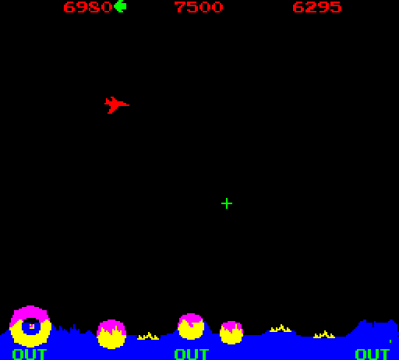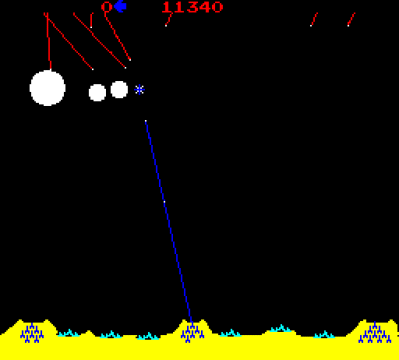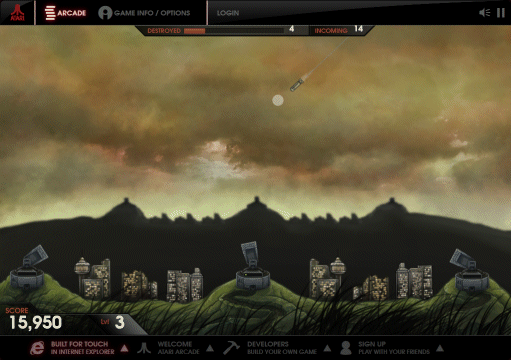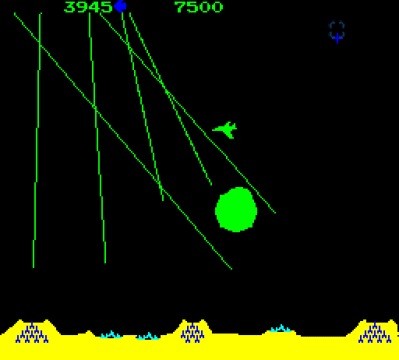Missile Command - 1980
| Year: | 1980 |
| Original platform: | Arcade machine, game console |
| Brief description: | Missile warfare simulation |
| Number of players: | One or two |
| Developers/contributors: | Atari Inc. |
Missile Command was a popular Atari arcade game that followed hot on the heels of Space Invaders and Asteroids. Although perhaps not in the same league as its predecessors in terms of the total amount of revenue it generated, Missile Command was nevertheless financially successful, and can be counted as one of the classic video arcade games. For some, it was also a chilling reminder of the very real dangers of a nuclear confrontation.
At the time of its release the Cold War was very much ongoing, and Russian forces had occupied Afghanistan during the previous year, raising global tensions. The game concept is simple. The player must defend six cities from multiple incoming missiles using their own anti-missile missiles. As with Space Invaders and Asteroids, this is a game that ultimately cannot be won. The player simply tries to survive as long as possible. The more incoming missiles the player manages to destroy, the higher their score will be.
The idea for the game was apparently inspired by a magazine article about satellites which was read by Atari's president Ray Kassar, who passed the article to Atari engineer Lyle Rains. Rains in turn assigned the task of designing the game to developer Dave Theurer. The original requirement was for a game in which the player had to defend a number of cities on the coast of California, including San Francisco, Santa Barbara and Los Angeles, from a nuclear missile attack.
The explicit identification of geographical locations was later dropped from the specification, possibly because members of the development team were uncomfortable with the idea of a game in which actual US cities were being targeted by nuclear missiles. Even so, Theurer and several other members of the development team reportedly suffered from nightmares during the development process that involved the destruction of US cities in a nuclear holocaust.

The game ends when all of the player's cities are destroyed
The game was originally intended to be called "Armageddon", the name favoured by the Atari design team. Atari's management disagreed, however, asserting that the target audience would not grasp the significance of the name. The apocalyptic nature of the game is at least acknowledged on the final screen, in which the message "The End" replaces the more familiar "Game Over".
If the player has achieved a sufficiently high score, the end screen is replaced by a screen that prompts the player to enter their initials. There is a nicely ironic touch in one scene of the film Terminator 2: Judgement Day. One of the film's main characters, the young John Connor, is seen playing Missile Command on an arcade machine.
Like Asteroids before it, Missile Command employed a MOS 6502 processor, although the display was implemented using raster (bitmapped) graphics, and the sound was controlled by a single integrated circuit. The arcade version of the game was produced in a variety of cabinet styles, including upright and cocktail table versions. Missile Command also enjoyed a colour display, with a palette of eight colours.
One interesting innovation was the use of a trackball, which was used to position the cursor on the screen. The trackball replaced the buttons typically used up until that time to move on-screen objects left and right, or up and down. At the time, pointing devices such as the computer mouse were still not widely used, with user input on most personal computers still restricted to the keyboard. Buttons were still used to launch missiles from the missile batteries controlled by the player.
Gameplay is relatively straightforward. The player is in control of three missile batteries, each of which has ten missiles. The missiles are launched using a launch button (each missile battery has its own button). There are six cities in total, situated at points along the bottom of the screen. Once the game has started, inbound missiles begin to appear at the top of the screen. The player's task is to destroy these inbound missiles using their own missiles before they can reach their targets (which can be either the cities or the player's missile batteries).
The player can target the inbound missiles by using the trackball to position the cursor (which takes the form of a cross-hair) just ahead of an incoming missile. When the player launches a missile, it homes in on the cursor's position at the time the missile is launched, after which the player can move the cursor in order to target another inbound missile. The game is over when all of the cities have been destroyed.

Aim to detonate your missile just ahead of incoming missiles
If the missiles (which keep on coming) were the only problem you had to deal with, life would be far too easy. Well, that was the way the Atari game designers saw it, anyway. From the second wave of missiles onwards, for example, some of the inbound projectiles will split up into several independently-targeted warheads. If a city or a defensive missile battery is hit by an incoming missile, it will be totally destroyed. Destroyed cities are not restored until the player has achieved a certain number of points, but missile batteries are restored at the end of each attack wave.
If a player uses up all of their missiles, or if all of their missile batteries are destroyed, they are defenceless until the next wave begins. After the initial wave of incoming missiles has either been destroyed or reached its targets, the player is awarded points for incoming missile destroyed (twenty-five points each), for any cities that remain intact (one hundred points each), and for any unused defensive missiles (five points each).
From the second wave onwards, the player is faced with additional protagonists in the form of a "killer satellite" and a bomber, both of which traverse the screen horizontally, and both of which may launch additional missiles. Destroying a killer satellite or a bomber earns the player an additional one hundred points. Successive waves produce greater numbers of incoming missiles moving at greater speed.
Presumably to compensate for the increasing level of difficulty, the basic points awarded for destroying enemy targets, the points awarded for any surviving cities, and the points awarded for unused missiles is increased every two waves by applying a multiplication factor. For example, the points awarded are doubled for the third and fourth waves, trebled for the fifth and sixth waves, and so on. From wave eleven onwards, the points are awarded using a multiplication factor of six.
For every ten thousand points scored, the player is awarded a bonus city. Once awarded, the bonus city will only appear on screen once the current wave is complete, and then only if there are less than six cities already on screen. To spice things up even more, the game designers at Atari decided to add a "smart bomb" that appears during wave five.
The smart bomb (as its name suggests) has a certain amount of intelligence in the sense that it can detect a defensive missile detonation and attempt to avoid it. Although not invulnerable, this makes the smart bomb more difficult to destroy than other inbound missiles (destroying a smart bomb earns an additional one hundred and twenty-five points).
Defensive strategies mainly hinge on being able to anticipate where incoming missiles will be at a certain point in time and trying to ensure that one of your defensive missiles detonates in that location at the right time. The defensive missile will detonate at the location pinpointed by the cursor's cross-hairs when the launch button is pressed, and the detonation will have a significantly large blast radius centred on that point. With careful targeting and a certain amount of foresight, it is possible to take out two or more enemy warheads and/or killer satellites and/or bombers with a single missile.
The Atari game designers pretty much knew that they had another hit arcade game on their hands because of the number of Atari staff playing the game in their free time (and sometimes during work time). The game was duly ported to the Atari 2600 game console, as well as to other Atari consoles and personal computers. The console version, however, removes the action from planet Earth altogether. The scenario in the game manual is described as an interplanetary conflict between the warlike inhabitants of the planet Krytol and the peaceful (though apparently heavily armed) inhabitants of the planet Zardon.
Atari also licensed the game to Sega for the European market, and to Taito for the Japanese market. In fact, the popularity of the game was such that it has appeared on nearly every platform that has emerged since 1980, including mobile devices such as the iPad and iPhone. In addition to the online versions referenced above, you can play an updated online version of Missile Command on Atari's website here.

Play this updated version of Missile Command on Atari's website

